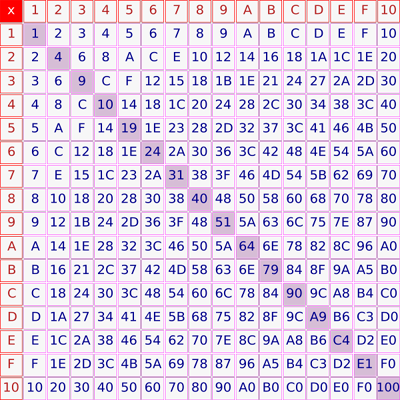In Olaf Stapledon’s 1935 science fiction novel “Odd John,” an evolutionary leap of a human child wonders why we built our number system on units of ten. After all, the number twelve has six factors, meaning it is divisible by six numbers, {1, 2, 3, 4, 6, 12}, while ten only has four factors, {1, 2, 5, 10}. Wouldn’t a base-12 number system be more practical?
In our decimal (base-10) number system, the number dial flips every ten units. After the number nine, we go back to zero and put a one in front of it in the tenths place (10). When the tenths place reaches nine and the one’s place reaches nine for 99 units, we flip them both to zero and add a one in front of them at the hundredth’s place (100).
Having a duodecimal (base-12) number system would mean flipping back to zero every 12 units. So after “9,” we would have “A” (or some other symbol representing 10), and “B” (or some other symbol for 11). So 8.. 9… A… B… 10, where the “1” is the twelve’s place (known as the “dozen” place), so a duodecimal “10” is our decimal 12. Similarly, 12X12, or 124 is represented by “100.” So counting up: B8… B9… BA… BB… 100.
 Duodecimal Multiplication Table Credit: RodrigoSampaioPrimo |
Does this seem otherworldly? Then consider this, days and nights are measured in 12-hour blocks, with hours subdivided into 60 minutes and minutes in to 60 seconds, all divisible by 12. We use a duodecimal number system to measure time; although we annotate it in decimal.
In the digital universe that exists inside of our computers, everything must begin with the bit, enough room to store a single unit of data. This means computers must use a base-2 number system, also known as binary. Counting up, after the number one, we flip to zero with a “1” in the second place (known as the “pair”), so the number 2 is represented by “10,” three by “11,” four by “100,” five by “101,” six by “110”, seven by “111,” and eight by “1000.” Every one or zero in the digital ecosystem taking up one bit of space.
It’s difficult for humans to work with the long strings of ones and zeros in binary number systems, and binary’s powers, {1, 2, 4, 8, 16, 32, 64…} do not divide, and therefore translate, well into our decimal system {1, 2, 5, 10}. For this reason, many computer programmers rely on a hexadecimal (base-16) number system, which counts up as 8… 9… A… B… C… D… E… F… 10. With “10” representing decimal’s 16.
 Hexadecimal Multiplication Table Credit: Bernard Ladenthin |
This way, a single hexadecimal symbol can represent up to four binary symbols. Hexadecimal’s “F” represents decimal’s 15 and binary’s “1111.” The World Wide Web uses hexadecimal triplets to define Red, Green, and Blue (R,G,B) values for colors on web pages. For example (0,0,0) or “#000000” translates to zero Red, zero Green, zero Blue, which is black, and (FF,FF,FF) or “#FFFFFF” translates to 256 Red, 256 Green, and 256 Blue, which is white. “#00FF00” is Green, and “#008800” is light green. Setting any of these values between zero and FF will give you 24-bit color, nearly all of the colors in the visible spectrum.
So we’ve played with powers of one, powers of 10, powers of 12, and powers of 16, but there are many more. There is quinary (base-5) and vigesimal (base-20). The ancient Sumerians used a sexagesimal (base-60) number system, which was adopted by the Babylonians. If this sounds extremely out there, consider that we still have the remnant’s of this system in our modern measurements of time (60 minutes, 60 seconds), angles and geographic coordinates (360 degrees).
With so many options available to us, why do we use a decimal number system?
Because it’s the number of fingers we have on our hands!
Additional Notes:
If I could change one thing—this is going to sound stupid—but if I could go back in time and change one thing, I might try to interest some early preliterate people in not ! using their thumbs when they count It could have been the Standard, and it would have made a whole lot of things easier in the modem era. On the other hand, we have learned a lot from the struggle with the incompatibility of base-ten with powers of two.
Comments
23 responses to “Why a Base-10 Number System?”